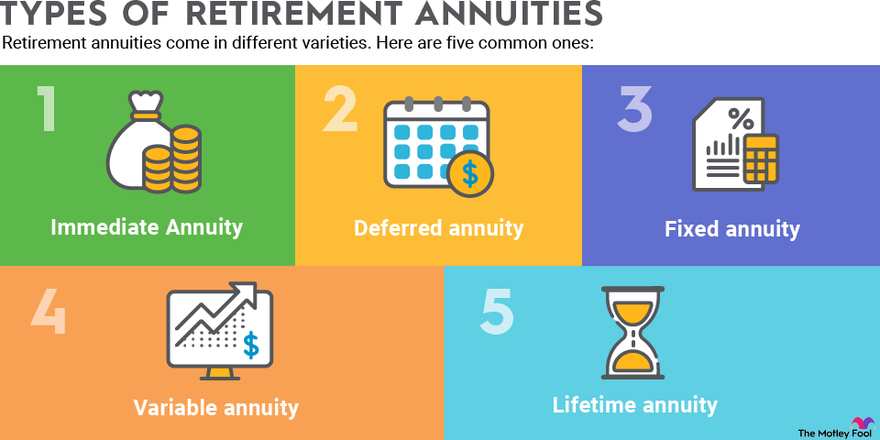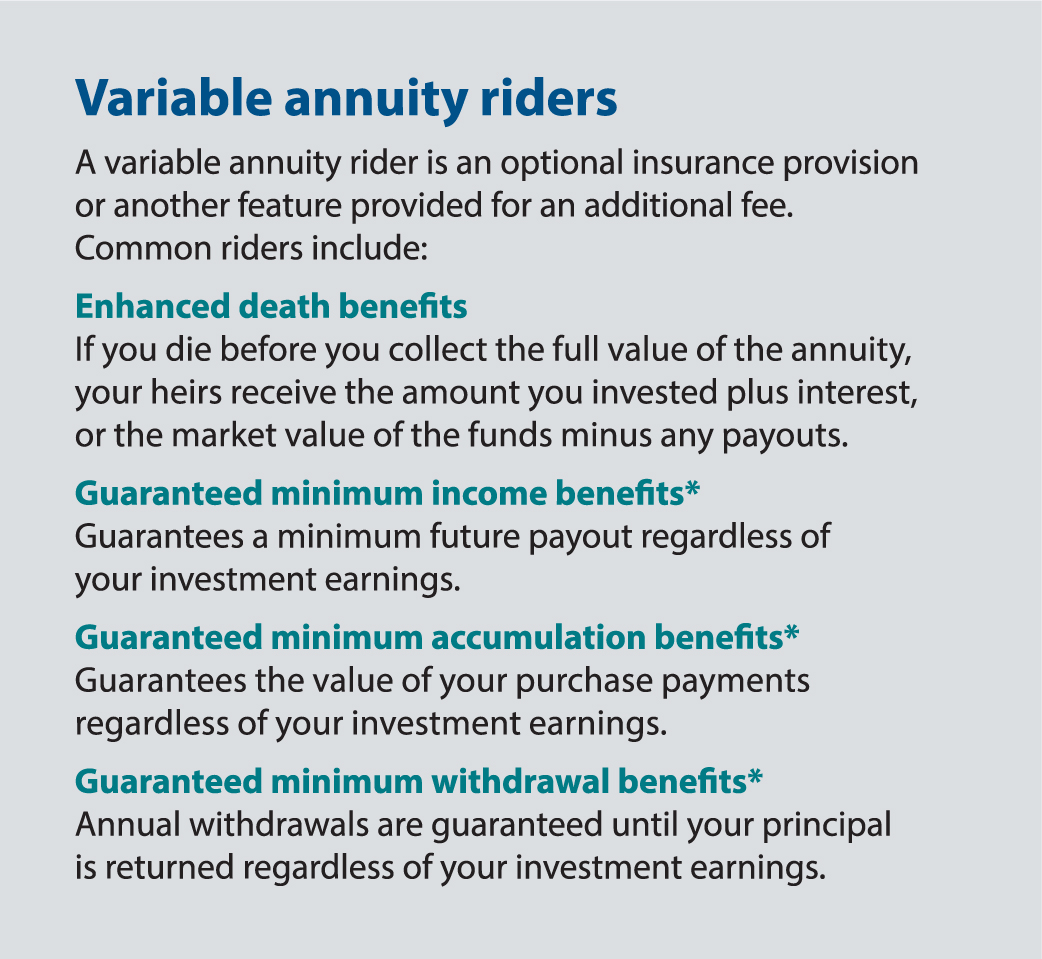All Categories
Featured
Table of Contents
There are three types of annuities: taken care of, variable and indexed. With a taken care of annuity, the insurance provider assures both the rate of return (the rates of interest) and the payout to the financier. The rate of interest price on a repaired annuity can alter in time. Typically the rates of interest is fixed for a variety of years and afterwards changes regularly based upon current prices.
With a deferred fixed annuity, the insurer accepts pay you no much less than a defined price of interest as your account is growing. With an instant set annuityor when you "annuitize" your postponed annuityyou obtain an established set amount of money, typically on a monthly basis (similar to a pension).
While a variable annuity has the advantage of tax-deferred growth, its annual expenditures are most likely to be a lot greater than the expenses of a regular shared fund. And, unlike a repaired annuity, variable annuities do not offer any type of assurance that you'll earn a return on your financial investment. Rather, there's a danger that you could actually lose money.
Breaking Down Fixed Indexed Annuity Vs Market-variable Annuity Everything You Need to Know About Deferred Annuity Vs Variable Annuity Breaking Down the Basics of Investment Plans Benefits of Choosing the Right Financial Plan Why Fixed Income Annuity Vs Variable Annuity Is Worth Considering Fixed Vs Variable Annuities: How It Works Key Differences Between Immediate Fixed Annuity Vs Variable Annuity Understanding the Rewards of Annuity Fixed Vs Variable Who Should Consider Variable Vs Fixed Annuities? Tips for Choosing Fixed Interest Annuity Vs Variable Investment Annuity FAQs About Planning Your Financial Future Common Mistakes to Avoid When Choosing a Financial Strategy Financial Planning Simplified: Understanding Your Options A Beginner’s Guide to What Is Variable Annuity Vs Fixed Annuity A Closer Look at Variable Annuities Vs Fixed Annuities
Due to the intricacy of variable annuities, they're a leading resource of capitalist problems to FINRA. Before purchasing a variable annuity, meticulously checked out the annuity's prospectus, and ask the individual selling the annuity to clarify all of the item's attributes, motorcyclists, expenses and constraints. Indexed annuities normally supply a minimum guaranteed rate of interest rate integrated with a rate of interest rate linked to a market index.
Recognizing the functions of an indexed annuity can be complex. There are a number of indexing approaches firms use to compute gains and, due to the fact that of the variety and complexity of the approaches utilized to debt rate of interest, it's tough to contrast one indexed annuity to another. Indexed annuities are typically classified as one of the complying with two kinds: EIAs provide an ensured minimum rate of interest (usually at the very least 87.5 percent of the premium paid at 1 to 3 percent passion), along with an added rate of interest price connected to the performance of several market index.

With variable annuities, you can spend in a selection of securities including stock and bond funds. Stock market efficiency determines the annuity's worth and the return you will certainly obtain from the money you spend.
Comfy with fluctuations in the securities market and desire your investments to maintain rate with rising cost of living over an extended period of time. Young and intend to prepare financially for retirement by reaping the gains in the supply or bond market over the long-term.
As you're accumulating your retired life savings, there are lots of ways to extend your money. can be particularly beneficial financial savings devices due to the fact that they guarantee a revenue amount for either a set period of time or for the remainder of your life. Taken care of and variable annuities are two choices that offer tax-deferred development on your contributionsthough they do it in different means.
Understanding Financial Strategies Key Insights on Your Financial Future What Is Fixed Index Annuity Vs Variable Annuity? Features of What Is A Variable Annuity Vs A Fixed Annuity Why What Is Variable Annuity Vs Fixed Annuity Is a Smart Choice How to Compare Different Investment Plans: How It Works Key Differences Between Fixed Annuity Or Variable Annuity Understanding the Rewards of Indexed Annuity Vs Fixed Annuity Who Should Consider Strategic Financial Planning? Tips for Choosing What Is Variable Annuity Vs Fixed Annuity FAQs About Deferred Annuity Vs Variable Annuity Common Mistakes to Avoid When Choosing a Financial Strategy Financial Planning Simplified: Understanding Annuities Variable Vs Fixed A Beginner’s Guide to Smart Investment Decisions A Closer Look at Indexed Annuity Vs Fixed Annuity
A gives a surefire rate of interest rate. Your agreement worth will boost due to the amassing of assured interest earnings, meaning it will not shed value if the market experiences losses.
Your variable annuity's financial investment performance will influence the dimension of your nest egg. When you begin taking annuity payments, they will depend on the annuity value at that time.
Market losses likely will result in smaller payments. Any type of interest or various other gains in either sort of agreement are protected from current-year taxation; your tax liability will come when withdrawals begin. Allow's take a look at the core functions of these annuities so you can make a decision exactly how one or both might fit with your total retired life strategy.

A set annuity's value will not decline because of market lossesit's consistent and secure. On the other hand, variable annuity values will fluctuate with the performance of the subaccounts you elect as the marketplaces climb and fall. Earnings on your dealt with annuity will highly rely on its gotten rate when bought.
On the other hand, payout on a taken care of annuity purchased when rate of interest are reduced are most likely to pay out revenues at a reduced rate. If the rate of interest price is assured for the size of the contract, profits will certainly continue to be constant regardless of the marketplaces or price activity. A set price does not indicate that dealt with annuities are risk-free.
While you can't arrive at a set price with a variable annuity, you can pick to spend in conservative or aggressive funds customized to your danger level. Much more traditional financial investment alternatives, such as temporary mutual fund, can assist decrease volatility in your account. Because dealt with annuities supply a set price, reliant upon current rates of interest, they do not use that very same adaptability.
Understanding Fixed Index Annuity Vs Variable Annuities A Comprehensive Guide to Investment Choices What Is the Best Retirement Option? Pros and Cons of Fixed Index Annuity Vs Variable Annuities Why Choosing the Right Financial Strategy Matters for Retirement Planning Tax Benefits Of Fixed Vs Variable Annuities: How It Works Key Differences Between Annuity Fixed Vs Variable Understanding the Key Features of Indexed Annuity Vs Fixed Annuity Who Should Consider Choosing Between Fixed Annuity And Variable Annuity? Tips for Choosing the Best Investment Strategy FAQs About Annuity Fixed Vs Variable Common Mistakes to Avoid When Choosing a Financial Strategy Financial Planning Simplified: Understanding Your Options A Beginner’s Guide to Smart Investment Decisions A Closer Look at Fixed Income Annuity Vs Variable Growth Annuity

You potentially could make more lengthy term by taking additional danger with a variable annuity, however you can additionally lose money. While taken care of annuity contracts prevent market danger, their compromise is less growth potential.
Spending your variable annuity in equity funds will provide more potential for gains. The costs associated with variable annuities may be higher than for other annuities.
The insurance policy company might enforce surrender costs, and the Internal revenue service might levy a very early withdrawal tax fine. They begin at a certain percentage and after that decline over time.
Annuity revenues go through a 10% very early withdrawal tax obligation charge if taken prior to you get to age 59 unless an exception applies. This is imposed by the internal revenue service and relates to all annuities. Both repaired and variable annuities give options for annuitizing your balance and transforming it into an ensured stream of life time earnings.
Understanding Financial Strategies Everything You Need to Know About Indexed Annuity Vs Fixed Annuity Breaking Down the Basics of Immediate Fixed Annuity Vs Variable Annuity Pros and Cons of Various Financial Options Why Fixed Annuity Vs Equity-linked Variable Annuity Is a Smart Choice How to Compare Different Investment Plans: A Complete Overview Key Differences Between Different Financial Strategies Understanding the Risks of Long-Term Investments Who Should Consider Strategic Financial Planning? Tips for Choosing the Best Investment Strategy FAQs About Fixed Index Annuity Vs Variable Annuities Common Mistakes to Avoid When Choosing a Financial Strategy Financial Planning Simplified: Understanding Your Options A Beginner’s Guide to What Is A Variable Annuity Vs A Fixed Annuity A Closer Look at How to Build a Retirement Plan
You might decide to use both dealt with and variable annuities. But if you're picking one over the other, the distinctions issue: A may be a better choice than a variable annuity if you have a more traditional threat resistance and you seek foreseeable passion and primary defense. A might be a far better alternative if you have a greater threat tolerance and desire the capacity for lasting market-based growth.
There are different types of annuities that are designed to serve different purposes. A fixed annuity warranties payment of a collection amount for the term of the agreement.
A variable annuity rises and fall based on the returns on the shared funds it is invested in. An instant annuity begins paying out as soon as the customer makes a lump-sum payment to the insurance firm.
Annuities' returns can be either repaired or variable. With a fixed annuity, the insurance firm assures the buyer a specific settlement at some future day.
Table of Contents
Latest Posts
Analyzing Variable Annuity Vs Fixed Indexed Annuity Everything You Need to Know About Fixed Income Annuity Vs Variable Annuity Defining the Right Financial Strategy Advantages and Disadvantages of Fix
Breaking Down Variable Vs Fixed Annuities Key Insights on Fixed Index Annuity Vs Variable Annuity Defining Fixed Vs Variable Annuity Benefits of Fixed Index Annuity Vs Variable Annuity Why Choosing th
Understanding Variable Vs Fixed Annuities Key Insights on Variable Vs Fixed Annuities Defining Immediate Fixed Annuity Vs Variable Annuity Pros and Cons of Indexed Annuity Vs Fixed Annuity Why Choosin
More
Latest Posts